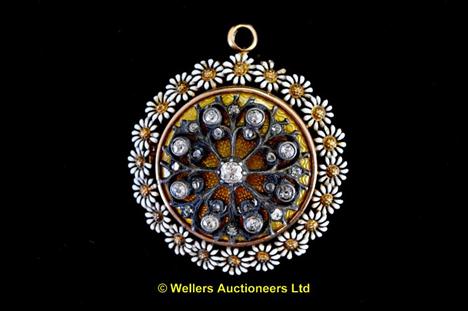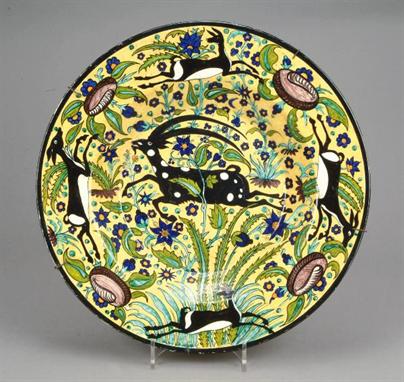We found 456 price guide item(s) matching your search
There are 456 lots that match your search criteria. Subscribe now to get instant access to the full price guide service.
Click here to subscribe- List
- Grid
A paper knife, unmarked, possibly silvered bronze, after a design by Michaelangelo Caetani for Castellani, the handle modelled as an angel with crossed arms and scroll motifs, the blade modelled as conjoined angels wings, length 25.7cm. For an image of the drawing for the design of this paper knife see: Castellani and Italian Archaelogical Jewelry, edited by Susan Weber Soros and Stefanie Walker, Yale University Press 2004, page 42.
A mid Victorian gold, enamel and sapphire Renaissance Revival pendant by Robert Phillips of Cockspur Street, dated 1879, of quatrefoil cruciform design, centrally set with four cabochon sapphires to cross arms of black enamel above quatrefoils of white enamel and gold wire work, with three 6mm pearls drops suspended beneath, the reverse with a hinged glazed locket enamelled with the dedication `Elizabeth Mary Rolls May 7 1879`, the plain pendant bale applied with Robert Phillips entwined double P monogram with Prince of Wales Feathers maker`s mark, 7.2cm long, in a later fitted Wartski black leather bound case. From biographical research, the enamel dedication on the back of this locket indicates the pendant may have been made to commemorate the death of Elizabeth Mary Rolls (nee Long, 1813 - 1879). Elizabeth Long was the granddaughter of William Carnegie, 7th Earl of Northesk, and in 1833 married John Etherington Welch Rolls, who became High Sheriff of Monmouthshire in 1842. Their grandson, Charles Rolls, became the co-founder of Rolls Royce motor cars with Frederick Henry Royce in 1906. Literature: Munn, G., `Castellani And Giuliano: Revivalist Jewellers Of The Nineteenth Century`, London 1984, p. 189 for an illustration of this pendant. Gere, C., and Munn, G., `Pre-Raphelite To Arts And Crafts Jewellery`, Suffolk 1996, p. 102 for an illustration of this pendant and an explanation of the influence of Tudor and Stuart jewellery on the designs of Robert Phillips. Gere, C. and Rudoe, J., `Jewellery In The Age Of Queen Victoria`, London 2010, p. 349 for an illustration another example of this design by Robert Phillips, now in the Hull Grundy Gift Collection at the British Museum
Carlo Giuliano fine enamel and diamond pendant/brooch, the golden guilloché enamel work set with diamonds in a decorated grillwork in the Gothic style, with a border of enamel daisies, a retractable pendant loop at the top, stamped CG in an oval. Circa 1880.Giuliano served his apprenticeship with Castellani before setting up his own retail premises in Piccadilly in 1874, Carlo Giuliano, leading figure in 19th Century Classical and Renaissance Revivalist Jewellery celebrated for his accomplished use of enamel. His Art jewellery is notable for its original and understated elegance, using subtle gemstones which blended very well with gold settings and were embellished with intricate enamel work. Upon his death, the company passed to Carlo`s two sons, Arthur Alphonse (1864-1914) and Carlo, who maintained their father`s success with many royal commissions, until the firm closed in 1914 with the death of Arthur."
CASTELLANI AND CAETANI - An ivory paper knife designed by Michaelangelo Caetani, made and retailed in the Castellani showroom, Rome, circa 1880, modelled as a standing angel, hands clasped in prayer and her wings elongated and upright forming the blade 26cm long Note: See Castellani, by Susan Weber Soros and Stefanie Walker, illus. p 42, fig. 2-14 and discussed pages 40-41
A mid 19th Century Castellani gold and Pietra dura micro mosaic pendant of stylised crucifix form, the dark and pale greens emblematic of heaven and earth, the Greek symbols pi, omega and sigma standing for light and zeta, omega, eta for life, with raised decoration verso and intertwined reversed "C"s for Castellani, approx 3.8 cm x 3.8 cm not including loop (ILLUSTRATED)
A 19th century Egyptian revival, gold, winged scarab brooch in the manner of Castellani, at the centre of the outstretched wings a scarab impressed with hieroglyphs, slight trace of previous enamelling to the wings, width 3.8cm, the silk covered box with the retailer`s label of Emil Capper of Prag, Karlsbad, Dresden and Munchen. (See illustration)
A GILT-BRONZE COMMEMORATIVE CHESS PIECE BY CARLO AND ARTHUR GIULIANO Modelled as a rook, the top inset with a section of Trans-Atlantic telegraph wire, engraved 'CHESS MATCH BY CABLE BETWEEN HOUSE OF COMMONS, LONDON AND HOUSE OF REPRESENTATIVES, WASHINGTON PLAYED OVER THE LINES OF THE ANGLO AMERICAN TELEGRAPH CO. LONDON AND WESTERN UNION TELEGRAPH CO, NEW YORK 1897' and 'CONTRACTORS THE TELEGRAPH CONSTRUCTION AND MAINTENANCE CO., LONDON', stamped 'C&AG' 3 in. (7.5 cm.) high Together with a booklet entitled 'CABLE CHESS MATCH SOUVENIR', edited by W. H. Watts, published London 1926; and Geoffrey G. Munn, Castellani and Giuliano Revivalist Jewellers of the Nineteenth Century, published 1984 View on Christie's.com
A Victorian gold and gem set Renaissance Revival brooch by Carlo Giuliano, circa 1875, designed by Pasquale Novissimo, the central moonstone cabochon rub over set above peridot cabochon ‘leaves’, within a black and white fleur de lys style border with bright red enamel dot accents between, CG plaque applied to the brooch pin fitting, 3.2cm diameter, in a fitted octagonal brown leather bound case, the lid lined with silk stamped in gilt C. Giuliano 115, Piccadilly London. The C.G plaque is the second mark for Carlo Giuliano used between 1863 and 1895. Pasquale Novissimo was the chief designer at the Piccadilly branch of Giuliano from 1874 until 1914. Many of his original designs have survived in his family archives. Literature: Munn, G. C., ‘Castellani And Giuliano: Renaissance Jewellers Of The Nineteenth Century’; London 1984, pp 71-73 for illustrations of Novissimo’s designs for Giuliano and plate 70, p 73, for a similar pendant to the one offered here.
A gold archaeological revival fob by Carlo Giuliano, a series of four rectangular plaque links, each with an applied repousse theatrical mask in the Greek and Roman taste, joined with spiral style hinges. Three graduated beads to the top with a trefoil cluster at the bottom. Maker’s mark verso. A later replacement swivel clip to the top, with a later bolt ring to the bottom, with a Victorian matching gold hardstone seal and watch key, both decorated with blue enamel (3) Carlo Giuliano (1831-1895) It is believed Giuliano began work in Naples for the Castellani workshop, before moving to London to open a workshop for Alessandro Castellani. His early archaeological revival work is similar to that of Castellani, with his later Renaissance Revival style jewellery proving extremely popular. For illustrations of other pieces of this type, please see Geoffrey C Munn ‘Castellani and Giuliano: Revivalist Jewellers of the Nineteenth Century’, illustration 103, or Lot 9 from ‘The Judith H Siegel Collection’, 06/12/2006, New York.
A mid 19th century gold and hardstone intaglioArcheological Revival bracelet by Castellani,circa 1860, composed of six circular and ovalpanels, alternately set with three oval intagliosardonyxes, each depicting classical gods, andthree oval cornelian intagios, depicting an ant,a leaping horse and a man on horseback, theintaglios possibly ancient, all rub over set inoval panels with foxtail wire decoration, withfigure of eight links between and a double hookclasp, applied with two intertwined `C`s forCastellani, 18,5cm long overallLiterature:Bennett D. & Mascetti D., `UnderstandingJewellery`, Antique Collectors Club, Suffolk,1989, pp 182 - 183 for illustrations ofArcheological Revival bracelets by Castellani,and plate 279 p. 183 for a similar intagliobracelet by Pierret of Rome.
"Box 217 Italian Red Wines Masseria Altemura Fiano Salento IGT 2007 Famiglia Piccini Rosso Toscana IGT Volorosso Sangiovese di Romagna DOC Superiore Romio 2007 Morattina Sangiovese di Romagna 2007 Masseria Altemura Fiano Salento IGT 2007 Volorosso Sangiovese di Romagna DOC Superiore Romio 2007 Vesevo Taurasi DOCG 2005 Castellani Villa Puccini Toscana IGT 2005 Sassabruna Monteregio di Massa Marittima DOC 2006 Masseria Altemura Negroamaro Salento IGT 2006 Morgante Don Antonio 2007 Moraia Il Pacchia Maremma Toscana IGT 2007 "
Torquato Castellani (1843-1931), an Italian dish shape maiolica charger, dated 1879, painted in Persian style with a central arabesque surrounded by antelope amidst flowers, on a blue ground, black painted mark `18 TC (monogram) 79 ROMA`, 47.5cm diameter. The National Museums of Scotland have three dishes of 1872 and a jug of 1871 by Castellani. Visit www.dnfa.com for condition reports
Torquato Castellani (1843-1931), an Italian dish shape maiolica charger, dated 1879, painted in Persian style with antelope amidst flowers and foliage, on a yellow ground, black painted mark `18 TC (monogram) 79 ROMA`, 48cm diameter. The National Museums of Scotland have three dishes of 1872 and a jug of 1871 by Castellani. Visit www.dnfa.com for condition reports
A mid Victorian Archaeological Revival gold and chrysoberyl catseye scarab ring by Castellani, circa 1870, the carved chrysoberyl scarab with an intaglio engraved base of a man’s head, claw set in a beaded swivel mount on a simple hoop shank with twisted wire shoulders, the inner shank base applied with Castellani`s intertwined double `C` mark, finger size I Visit www.dnfa.com for condition reports
A Victorian gold archaeological bangle by Robert Phillips, c. 1870, with an oval cabochon lapis lazuli within a frame of ivory coloured enamel circles with blue enamel centres and a twisted wire border, glazed locket verso to a tapered bangle, with the makers mark of Phillips of 23 Cockspur St, London Robert Phillips (d. 1881) was one of the first English jewellers to make 'Archaeological Revival' jewellery. The firm initially traded as Phillips Brothers at 31 Cockspur Street, then moved to no. 23 in 1855. In 1869 they traded as Phillips Brothers & Son, until Alfred Phillips took over in 1884. For further reading on Robert Phillips Cf: Geoffrey Munn 'Castellani and Giuliano, Revivalist Jewellers of the Nineteenth Century', 1984; Charlotte Gere and Geoffrey Munn 'Artists' Jewellery, Pre- Raphaelite to Arts & Crafts', 1989.
A fine Italian gold 'Archaeological' bracelet by Antonio Civilotti, c. 1850, the broad cylindrical head decorated with Etruscan beadwork and scrolls, with twin Ram's head finials, one of which removable to form the base of a pencil holder connected by a foxtail link chain to the mouth of the opposing ram The bracelet back is hinged and opens from two batons, the inner field of gold is applied with the Latin motto 'SALVE AEI A' (hail for ever), small dents, with complementary shotwork pyramids, one clasp finial deficient. Antonio Civilotti (1798-1870) was established as a goldsmith in Rome in 1830, where he remained until his death. He specialised in Renaissance and Classical themes, often incorporating hardstone cameos in portraits. This bangle is similar in style to the work of Castellani, Pierret and Antiono Carli For a comparable item see Lot 33, Phillips, London, Fine Jewellery sale, 22nd February 1994 (see lot 301 for illustration)
A FINE ARCHAEOLOGICAL REVIVAL YELLOW GOLD NECKLACE in the manner of Castellani, with a central Medusa mask suspended from a cupid's bow and flanked by graduated theatrical masks suspended from conforming cupid's bows alternating with stylised anthemia, the finely executed "rope" necklace incorporating a herringbone pattern, with an "S"-scroll clasp, in a fitted case. and back cover
















-201067115959_468x382.jpg)














